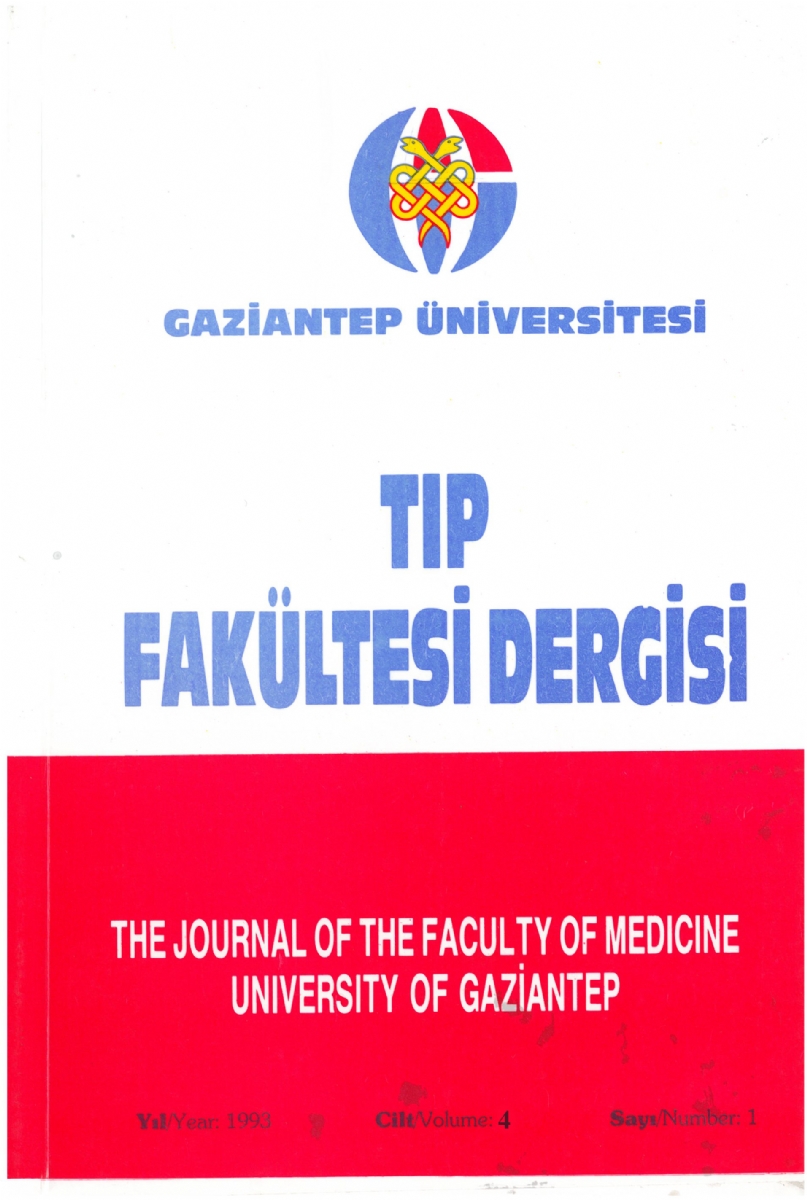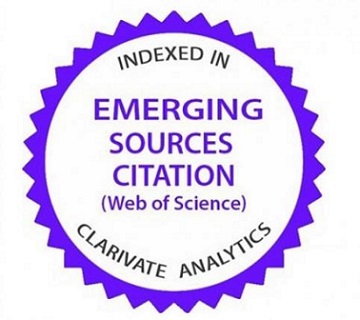Distribution and Susceptibilities to Various Antibiotics of Shigella Strains Isolated from Patients with Acute Diarrhea
[Akut Diareli Olgulardan İzole Edilen Shigella Türlerinin Dağılımı ve Çeşitli Antibiyotiklere Karşı Duyarlılıkları]
DOI:
https://doi.org/10.58600/eurjther-199342-1091-xKeywords:
Shigella species, Antibiotic susceptibilityAbstract
Shigellae are responsible for bacillary dysentery which causes high morbidity especially in developing countries. in this study stool samples of 735 patients whit acute diarrhea were examined and Shigella spp. were isolated in 79(10. 7 %). S.sonnei (44.3 %) was the most frequently isolated pathogen followed by S.boydii (24.0 %) S.flexneri (22.8 %) and S.dysenteriae (8.9 %) respectively. The mean age of patients was 12.85 and 0-5 age group had the highest frequency with a rate of 41.8 %. High resistance rates were found against tetracycline, ampicilline and trimethoprim-sulfamethoxazole (SXT) which were the drug of choice for the therapy of shigellosis until recent years, while quinolones and third generation cephalosporins were found to have highest in-vitro antibacterial activity.
Metrics
References
Bilgehan H.:Klinik Mikrobiyolojik tanı. Fakülteler Kitapevi İzmir, 1992, 386.
Echeverria P., Sethabutr O., Pitarangsi C.:Microbiology and diagnosis of infections with Shigella and enteroinvasive Esherichia coli. Rev lnfect Dis, 13(supp1 4):220-5, 1991.
Farmer fl., Kelly MT.:Enterobacteriaceae. In:Balows A, Hausler Jr WJ, Herrmann KL, Isenberg HD, Shadomy HJ:Manual of Clinical Microbiology. 5 th ed, American society for Microbiology, Washington DC, 1991.
Bennish ML.:Potentially lethal complications of shigellosis. Rev Infect Dis, 13(suppl 4):319-24, 1991.
Bennish ML., Wojtyniak BJ.:Mortality due to shigellosis:community and hospital data. Rev Infect Dis, 13(suppl 4):245-51, 1991.
Goren A., Freier S., Passwell JH.:Lethal toxic encephalopathy due to childhood shigellosis in a developed country. Pediatrics, 89:1189-93, 1992.
Henry FJ.:The epidemiologic importance of dysentery in communities. Rev Infect Dis, 13(supp1 4):238-44, 1991.
Al-Eissa Y., Al-Zamil F., AI-Kharashi M., et al.:The relative importance of Shigella in the aetiology of childhood gastroenteritis in Saudi Arabia. Scand J Infect Dis, 24:347-351, 1992.
Ferreccio C., Prado V., Ojeda A., et al.:Epidemiologic patterns of acute diarrhea and endemic Shigella infections in children in a poor periurban setting in Santiago, Chile.Am J Epidemiol, 134:614-27, 1991.
Baron EJ., Finegold SM.:Bailey and Scott's Diagnostic Microbiology. 8 th ed, The CV Mosby Company, St Louis, 1990.
Barry AL., Thornsberry C.:Susceptibility tests:diffusion test procedures. In:Balows A, Hausler Jr WJ, Herrmann KL, Isenberg HD, Shadomy HJ:Manual of Oinical Microbiology. 5 th ed, American society for Microbiology, Washington DC, 1991.
Thisyakom U, Rienprayoon S.:Shigellosis in Thai children:epidemiologic, clinical and laboratory features. Pediatr Infect Dis J, 11:213-5, 1992.
Kagalwalla AF., Khan SN., Kagalwalla YA., et al.:Childhood shigellosis in Saudi Arabia. Pediatr Infect Dis J, 11:215-9, 1992.
Levine 05., Levine MM.:Houseflies (Musca domestica) as mechanical vectors of shigellosis. Rev Infect Dis, 13:688-96, 1991.
Eko FO., Utsalo SJ.:Antimicrobial resistance trends of shigellae isolates from Calabar, Nigeria.J Trop Med Hyg, 94:407-10, 1991.
Lolekha S., Vivulbandhitkit S., Poonyarit P.:Response to antimicrobial therapy for shigellosis in Thailand. Rev Infect Dis, 13(suppl 4):342-6, 1991.
Kabir 1., Butler T., Khanam A.:Comperative efficacies of single intravenous doses of ceftriaxone and ampicillin for shigellosis in a placebo-controlled trial Antimicrob Agents Chemother, 29:645-8, 1986.
Gotuzzo E., Oberhelman RA., Maguina C., et al.:Comparison of single-dose treatrnent with norfloxacin and standart 5-day treatrnent with trimethoprim-sulfamethoxazole for acute shigellosis in adults. Antimicrob Agents Chemother, 33:1101-4, 1989.
Huilan S., Zhen LG., Mathan MM., et al.:Etiology of acute diarrhoea among children in developing countries:a multicentre study in five countries. Bull WHO, 69:549-55, 1991.
Salam MA., Bennish ML.:Antimicrobial therapy for shigellosis. Rev Infect Dis, 13(supp1 4):332-41, 1991.
Gross RJ., Threlfall EJ., Ward LR., Rowe B.:Drug resistance in shigella dysenteriae, Shigella · flexneri, and Shigella boydü in England and Wales:increasing incidence of resistence to trimethoprim. Br Med J, 288:784-6, 1984.
Lolekha S., Patanachareon S., Thanangkul B., Vibulbandhitkit S.:Norfloxacin versus cotrimoxazole in the treatrnent of acute bacterial diarrhoea:a placebo controlled study. Scand J Infect Dis, 56(supp1):35-45, 1988.
Meyer PW., Lerman S.:Rise and fail of Shigella antibiotic resistance. Antimicrob Agents Chemother, 17:101-2, 1980.
Ling J., Kam KM., Lam AW., French GL.:Susceptibilities of Hong Kong isolates of multiply resistant Shigella spp.to 25 antimicrobial agents, including ampicillin plus sulbactam and new 4 - quinolones. Antimicrob Agents Chemother, 32:20-3, 1988.
DuPont HL. :Use of quinolons in the treatment of gastrointestinal infections. Eur J Oin Microbiol Infect dis, 10:325-9, 1991.
Salam MA., Bennish ML.:Therapy for shigellosis:randomized, double blind trial of nalidixic acid in childhood shigellosis. J Pediatr, 113:901-7, 1988.
Carlson JR., Thomton SA., Dupont HL., et al.:Comperative in vitro activities of ten antimicrobial agents against bacterial enteropathogens. Antimicrob Agents Chemother, 24:509-13, 1983.
De Mol P., Mets T., Lagasse R., et al.:Treatment of bacillary dysentery:a comparison between enoxacin and nalidixic acid. J Antimicrob Chemother, 19:695-8, 1987.
Nelson JD., Haltalin KC.:Comperative efficacy of cephalexin and ampicillin for shigellosis and other types of acute diarrhea in infants and children. Antimicrob Agents Chemother, 7:415-20, 1975.
Orenstein WA., Ross L., Overturf GD., et al.:Antibiotic treatment of acute shigellosis: failure of cefamandole compared with trimethoprim/sul.famethoxazole and ampicillin. Am J Med Sci, 282:27-33, 1981.
Downloads
Published
How to Cite
Issue
Section
License
Copyright (c) 2023 European Journal of Therapeutics

This work is licensed under a Creative Commons Attribution-NonCommercial 4.0 International License.
The content of this journal is licensed under a Creative Commons Attribution-NonCommercial 4.0 International License.


















